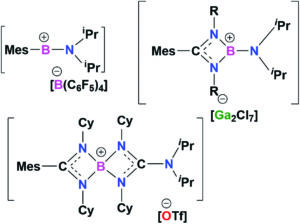Prof. Douglas Stephan and Dalton Transactions
This year, we are celebrating the 50th volume of Dalton Transactions by taking a look at some of our authors who have published over 50 articles in the journal. This week we learn what Dalton Transactions means to Professor Douglas Stephan.
Our authors at a glance:
Professor Douglas Stephan is based at the University of Toronto’s Department of Chemistry, where his research focuses on main group and organometallic chemistry, Frustrated Lewis pairs (FLPs) and catalysis. He chooses to publish in Dalton Transactions as it is “the signature journal for inorganic chemists around the world” reaching a broad readership across the inorganic community.
Please can you summarise your most recent research published in Dalton Transactions?
In our latest Dalton paper, we prepared the first stable C-B-N-substituted borinium cation [MesBNiPr2][B(C6F5)4] and examined its reactivity. We demonstrated that in reactions with isothiocyanate and carbodiimides, insertion into a B-C bond affords nitrilium and borenium amidinate salts, respectively.
How do you intend to expand upon your research in the future?
We are continuing to broaden the use of main group reagents for stoichiometric and catalytic FLP chemistry of interest. We are particularly focused on novel bond-forming reactions as well as avenues to the activation of very strong bonds.
What would you say are the biggest barriers which need to be overcome to expand your research?
We are learning new rules for the reactivity of main group chemistry, the challenge is seeing the broader implications and applications.
You’ve published over 50 articles in Dalton Transactions, which of these works do you find to be most interesting/significant for our broad inorganic audience?
Of our work published in Dalton Transactions, we have had a number of papers that have addressed aspects of FLP chemistry and new Lewis acids. I believe that some of these papers find readers outside of the main group or even inorganic communities.
Outside of your own research, please suggest a Dalton Transactions article which you think has made a significant contribution to its field?
Most recently I have been very excited to read the work from the group of Sjoerd Harder. One such paper was: Calcium catalyzed enantioselective intramolecular alkene hydroamination with chiral C2-symmetric bis-amide ligands
What advice do you have for young researchers new to your field?
The most interesting observations are often those that are contrary to the expected. When that happens, do not dismiss it as an error, embrace it as an opportunity.
What does Dalton Transactions mean to you?
Dalton Transactions is the signature journal for inorganic chemists around the world.
Why do you choose to publish in Dalton Transactions?
I choose Dalton as it is a journal for the broad inorganic community that has a broad readership.
What is your experience of publishing with Dalton Transactions?
I have always felt that work submitted to Dalton has been reviewed in a fair and timely fashion.
You can check out Douglas’ most recent Dalton Transactions article on the insertion reactions of the C–B–N-substituted borinium cation [MesBNiPr2]+ below.
Insertion r eactions of the C–B–N-substituted borinium cation [MesBNiPr2]+
eactions of the C–B–N-substituted borinium cation [MesBNiPr2]+
Karlee L. Bamford and Douglas W. Stephan,
Dalton Trans., 2020, 49, 17571-17577
Check out the full collection of recent research published in Dalton Transactions by all of our featured Golden Authors in our Celebrating our Golden Authors collection.











